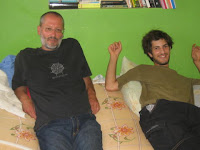
I met Khader working at Radio Isis in Beit Sahour. Khader dresses carefully and his hair is nicely groomed. Like others at the station he is Christian. I did not inquire which type but he seemed devout. In fact the people at the station were somewhat shocked when I said I am not religious. "How can that be?" was their response.
In one of our conversations Khader mentioned that he had spent some time in prison. I inquired and found out the following story which .... I have the impression ..... has been experienced by a high percentage of young Palestinian males. Many have faced and endure much worse.
It happened during the 2nd Intifada when Israeli troops laid siege to the Church of Nativity where some Palestinian fighters had sought refuge. For 72 hours there was a complete curfew in Bethlehem. Israelis surrounded and periodically shelled the cathedral for many weeks. Snipers were looking to shoot to kill.
During this period (April 2001) Israeli troops were going door to door at night in Bethlehem rounding up youth and 'suspects'. They banged on the door of Khader's parents house at 2 am.. Khader says his mother was crying; his father was angry but eventually also crying as the IDF found Khader in his room, checked his ID and took him away. He spent the next two days blindfolded with hands tied in a large holding area with many other people whom he could hear.
After two days his name was called and he was taken for interrogation by Captain Housne of the IDF. Housne is infamous in Bethlehem. Fluent in Arabic, he offered Khader coffee. Khader declined. Housne offered again, suggesting he accept and Khader said OK.
The interrogator then showed Khader a photo of some young men throwing rocks at a tank near the grounds of Al Quds University. Khader was in the photo. It was obviously him, and Khader saw no point in denying it. Housne said this is a serious offense but that he could help. The interrogator then went through a laundry list of things which could turn Khader into informant. Different things motivate different people.
Housne suggested that in exchange for information, he could settle the criminal charges agains Khader. No thanks.
Then there was money. "How are you paying for university? We could help you."
Then a car.
Then women. "We can get any girl for you .... Palestinian or Israeli..... wouldn't that be nice?"
Khader says he declined all of this. He knew what would be expected in return.
The interrogator next tried the religions angle. "How does it feel to be one of the few Christians at Al Quds University?" Khader responded, "No problem. We are Palestinian first of all. Plus we all believe in one God."
Following the interview Khader was taken to a prison near Hebron. His parents hired an attorney to contest the charges against him (for throwing a rock at tank). Khader says the attorney did a good job and got his sentence reduced from one year to six months.
He went to prison in Jerusalem. His cell mates were ages 18 and 31, from Nablus and Jenin in northern West Bank. Because Palestinians cannot enter Jerusalem without a special and very hard-to-get pass, his parents were only able to visit him once. His cellmates' families were never able to visit.
Khader says that the experience was very bad. He lost 15 pounds (he is thin) and says he got gray hairs because of the experience. He prayed to God and that helped.
After being released from prison in the Fall, he found that he had lost his university placement.
He worked to save money and re-enter the university. That finally happened in March of 2003. He completed his graduation requirements in January this year and is now working at Radio Isis.
This is an Every Palestinian story. What happened to Khader has happened (and worse) to hundreds of thousands of his brothers.
This is a success story. For every Khader there are many young men whose lives never get back on track.
 "Why do they hate us" would be a more appropriate question to be asked by everyday Palestinians. They are frequently on the receiving end of right wing hate. How many times have we seen or heard the words "Palestinian terrorist"? It is almost as if the words are coupled together.
"Why do they hate us" would be a more appropriate question to be asked by everyday Palestinians. They are frequently on the receiving end of right wing hate. How many times have we seen or heard the words "Palestinian terrorist"? It is almost as if the words are coupled together. Today throughout the Occupied territories Palestinians are facing the ongoing theft of their land and way of life. Three years ago they argued their case against the Israeli Wall before the International Court. They won the case but Israel has ignored the ruling and continues construction of Wall.
Today throughout the Occupied territories Palestinians are facing the ongoing theft of their land and way of life. Three years ago they argued their case against the Israeli Wall before the International Court. They won the case but Israel has ignored the ruling and continues construction of Wall.
































